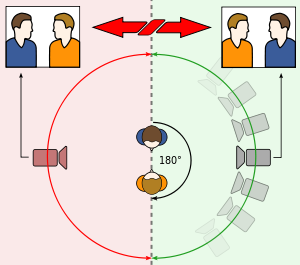Shot types are a vital way to tell the story and help the audience understand who has prevalence and significant characters stand out from the majority. There are a number of shots, these are:#
- The first camera shot I will be looking at is the Extreme Close Up Shot. This shot is focused on a specific detail of a person such as the eyes but it doesn't show the whole face. We are going to use this in our trailer when Aran; the main character has been knocked out and this will show that he is dazed and confused..
 |
| This shot is in Kill Bill and is used to identify a stand off and increase suspense. |
 |
| This character above is known as the Joker and he is the villain in Batman "the Dark Knight." The close up shot is used onn him to show his lack of expression and emphasise his trademark "Why so serious?" |
3. The third shot type is the Medium shot This shot is used to help the audience always be aware of the setting possibly because something may happen. In our movie. We will use this when Aran is sitting down on a sofa and someone enters the door in the background.
 |
| Here we've got a medium shot to remind us that there has been a murder in this room and a medium shot helps the audience remember this without taking any prevalence away from him. |
4. My fourth shot is a long shot. This is used to establish the setting and characters thus the long shot is also known as the Establishing shot. We may use a long shot while Aran is training not only to set the scene but to also show how hard he works.
 |
| We see a long shot which helps establish the four characters and help the audience identify that thy will play some part in the movie and we also see the setting which tells me that they live together. |
7. An extreme long shot focuses on where the movie will be set and is best used at the start of the movie or if the scene is changing. A good example of this is all three of the rush hour movies where they move from one country to another and that is where we see an extreme long shot. We will probably not use this in our trailer although it is used in trailers sometimes.
 |
| This will be a extreme long shot for a movie set in Hollywood or even Los Angles. |
6. I will now look at the low angled shot and its main purpose is to offer more prevalence to a character. We will use by making the villain look bigger than the victim thus meaning that he is the more important character in the movie. We will use this in the initial boxing fight to show the task that Aran is facing as we will make his villain look much bigger.
 |
| This shot is a low angle shot and offers more prevalence to the bigger character and makes him seem more powerful. |

In film making, the 180-degree rule, is a basic guideline regarding the on-screen spatial relationship between a character and another character or object within a scene. An imaginary line called the axis connects the characters and by keeping the camera on one side of this axis for every shot in the scene, the first character will always be frame right of the second character, who is then always frame left of the first. If the camera passes over the axis, it is called crossing the line or jumping the line.
Problem caused and Solutions
The
180-degree rule enables the audience to visually connect with unseen movement
happening around and behind the immediate subject and is important in the
narration of battle scenes. The visual disjointedness of the battle scene on Geonosis in the Star Wars film Attack of the
Clones is an example.
Avoiding crossing the line is a problem that those
learning film-craft will need to struggle with. In the above example with the
car chase, a possible solution is to begin the second cut with the car driving
into frame from the "wrong" side. Although this may be wrong in the geographic
sense on set, it looks more natural to the viewer. Another possibility is to
insert a "buffer shot" of the subject head-on (or from behind) to help the
viewer understand the camera movement.
The 180 degree rule has to be adhered to and is put in place to avoid confusion for the audience. If you were to abandon the 180 degree rule, then it would seem as if the character has changed position. As the graph above shows, anywhere in the green shaded area can be filmed from but if the camera were to go into the red shade area, then it would seem as if the two characters have switched positions, exactly same with the other picture you can also see the okay zones and wrong zones.
No comments:
Post a Comment